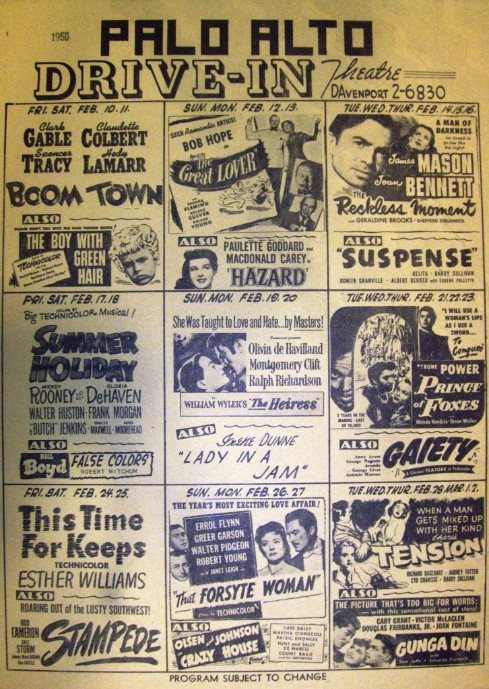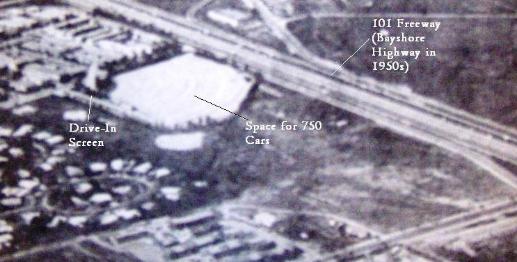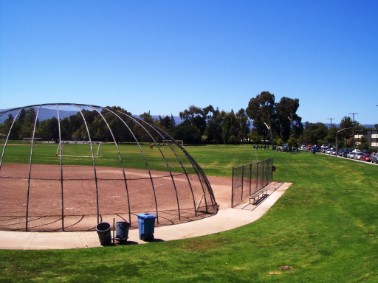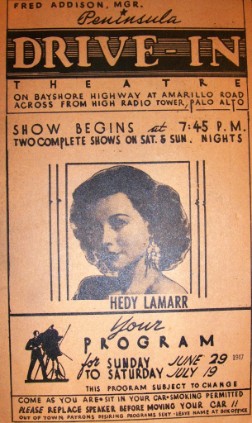The Palo Alto Drive-In: A Generational Memory
Kids running the bases these days at Greer Park have no knowledge that their ball field was once a theatre --- the old Palo Alto Drive-In Movie Theatre. And they wouldn’t be simply surprised to learn that the Drive-In once stood there, most would be befuddled by the concept entirely. For those of a certain age, the drive-in theatre stirs up memories of halcyon days of teenage revelry, backseat love affairs, and Hollywood’s epic years. While for the generations that followed, the whole concept of watching a movie in your car is a little hard to imagine.
The first person to imagine it was the sales manager at Camden, New Jersey’s Whiz Auto Products, Richard M. Hollingshead, Jr. After hearing his rather large mother complain one too many times about the slightness of movie theatre seats, Hollingshead began experimenting with projecting movies in his backyard.
With a bedsheet nailed to two trees in his backyard, this lover of movies and cars used a 1928 Kodak projector and a radio to entertain a few guests. Playing with the concept, Hollingshead propped up neighborhood cars on cinderblocks until he had sketched out a design for the perfect car ramp. It’s hard to imagine a simpler idea, but on May 16th, 1933, he received Patent #1,909,537 for his design of a ramp to allow passengers parked in cars to see over the heads --- or rather roofs --- of those in front.
In 1941, improved technology allowed large speakers blasting the soundtrack to be replaced by small movable speakers attached to posts next to each car --- and the drive-in movie was ready for the big time. After the war, the concept took off and by 1958 there were more than 4,000 drive-ins nationwide.
Palo Alto joined the bandwagon when the Peninsula Drive-In Theatre opened off old Bayshore Highway in 1947. An ad in the Palo Alto Times beckoned viewers to “see the stars --- under the stars” while promoting the grand opening week’s double feature --- teenage Shirley Temple’s “Kiss and Tell” and a feature-length Disney cartoon, “Make Mine Music.”
The Peninsula Drive-In (later renamed the Palo Alto Drive-In) consisted of a 70-foot screen --- said to be the largest in the western states at the time --- a snack bar, central projection house, and semi-circular ramp with the capacity to hold 750 cars. And the requisite small speakers could be hung inside the car (an announcement after the show urgently reminded viewers to put the speakers back in the receptaclebefore driving off.). Indeed, at just 60 cents per adult, 14 cents per child and “no charge for your car,” the Drive-In was one of Palo Alto’s most economical nights out.
Drive-ins primarily appealed to two rather different segments of American society. They were perfect for parents who could bring their little ones along in the backseat (sometimes already in PJs) and enjoy a movie without paying for a sitter. For teens, the drive-in offered a bit of much-desired privacy --- especially if you parked way in the back. A Nat King Cole song of the era proclaimed that at the drive-in “you’ll see more kisses in the car than on the screen,” and often kissing was just the beginning of the festivities. By the mid-‘50s the adults had caught on, and drive-ins were condemned as “passion pits” by disapproving clergy. In Palo Alto, as in other drive-ins, employees were known to patrol the lot, shining flashlights into cars when no heads were visible.
Indeed, in some ways drive-in theatres were never really about the movies. After all, your front windshield probably wasn’t the best showcase for the world’s cinematic masterpieces. The movies tended to be big and brash --- Hollywood at its most gargantuan. Palo Alto Drive-In fliers of the day advertise such long forgotten B-movies as “Wildfire” (“with thundering hoofs and thundering guns!”), “Summer Holiday,” (“a big Technicolor Musical!”) and “Stampede (“Roaring out of the Lusty West!”). One flier goes on to boast that a “a cast of 50,000” took three years to make the “Prince of Foxes,” and a pictures of Tyrone Power proclaiming, “I will use a woman’s lips as I use a sword…to conquer.” Yes, not exactly “Citizen Kane.”
Ironically, even as the movies got bigger and bigger, it was a smaller screen that would help bring down the drive-in. After reaching peak numbers in the late 1950s, close to 700 drive-ins would close over the next fifteenyears, including Palo Alto’s. And as daylight savings time, color television, the VCR and Cable TV all came into their own, drive-ins began to close up shop in the 1970s. By 1987, there were fewer than 1,000 in operation nationwide and only about 400 today.
While many drive-in owners cashed out by selling their land for housing or office parks, Palo Alto’s drive-in became city parkland. After closing, neighborhood activists rallied the City to purchase the land and combine it with bordering Amarillo Park to form a larger park. Over the course of the next twenty years Palo Alto would construct the extended Greer Park in a series of phases --- adding softball fields, basketball courts and eventually a skate park located at its southern edge.
Today a visit to Greer Park provides no hint that these grounds once hosted a storied slice of Americana. In Palo Alto --- as in much of America --- the drive-in movie must live on primarily in the minds of those who were there. []
Our Reader's Memories:
"The drive-in was the landmark at the end of Amarillo Ave in the 50's
and 60's. It was a treat for the whole family to go watch movies in the
car, and they even had a playground for kids up front, below the
screen.
In 1964, the Beatles' "Hard Day's Night" was shown there; each night
there would be cars lined up the length of Amarillo Ave. We knew when
the movie started each night because all the girls in the audience
would start screaming!"
-T
"In 1972, I lived in the house under the screen of the drive-in with my,
soon to be husband, Bob. He managed the drive-in from 1972 to 1974.
The movies of the time were Superfly, Freebie and the Bean and the
X-rated, Fritz the Cat. Many a night was spent knocking on steamy car
windows after the movie ended to get the patrons to drive home."
-Nichole
"I remember the small train that went around the screen and playland
in front of the screen. Watching the movie from the playland, straining
my neck. Going to the drive-in was family time."
-Joe
"I used to work at a company on W. Bayshore Rd. down the street just south of the old theater site around 1979. We drove to get lunch then someone said we could eat in the old abandoned theater lot. So we drove into the parking area and saw just bumpy parking lot with all the curved ridges for cars to park on. the screen was gone. the only way I could tell it was once a drive-in were the parking lot ridges. Over 30 yrs later, I have learned what the name of this place once was and what it used to be like...thanks to this archive.
-Dave
"In the early fifties I lived with my family just 5 housed away from the Palo Alto Drive-in on Amarillo St. (it was called then). There were pink and green neon lights on the back of the screen which was later widened to accommodate"wide screen" movies. I remember watching "High Noon" and "Some Like It Hot" there with my parents. I went to school with a little girl who's family managed the theater and lived in a small residence benieth the screen. Sometimes we would play there, during daylight hours, in the little playground or riding our bicycles recklessly on the ramps. I thought she was extremely lucky to live in such a novel place. We moved from the neighborhood in 1956 but I returned to the theater occasionally with dates once I had a driver's licence. Fond memories! I was sad to see it go."
-Richard
"Does anyone remember the old eucalyptus trees in the back of the drive in? My first memory of this drive-in started with the fence directly behind one of those eucalyptus trees of which we climbed to gain access to the movies. At 15 and 16 years old this was pretty cool but not as cool as coming back the next day with tools and supplies consisting of a hammer, wire cutters, nails, wood, 100 foot extension cord and electrical tape. We nailed wood slats up the back of that eucalyptus tree up to the first horizontal branch that faced the screen. You remember driving through all that gravel in the parking lot, it was perfect for hiding our extension cord that we ran up the back of that tree to our newly found pole speaker. I remember watching Planet of the Apes up there just teens monkeying around I guess. I also remember the train that use to run around the bottom of the screen it was not working at the time but in the basement underneath the screen in pieces. Very cool memories for me growing up in Palo Alto.
GENE WARD.
Send Us Your Memory!


An old newspaper photo of the drive-in theatre.

Greer Park today where the drive-in theatre once stood.

A freeway wall now stands where the entrance from old Bayshore Highway once stood.

A Google Image of Greer Park where the drive-in once stood.

A program from the old Peninsula Drive-In Theatre.